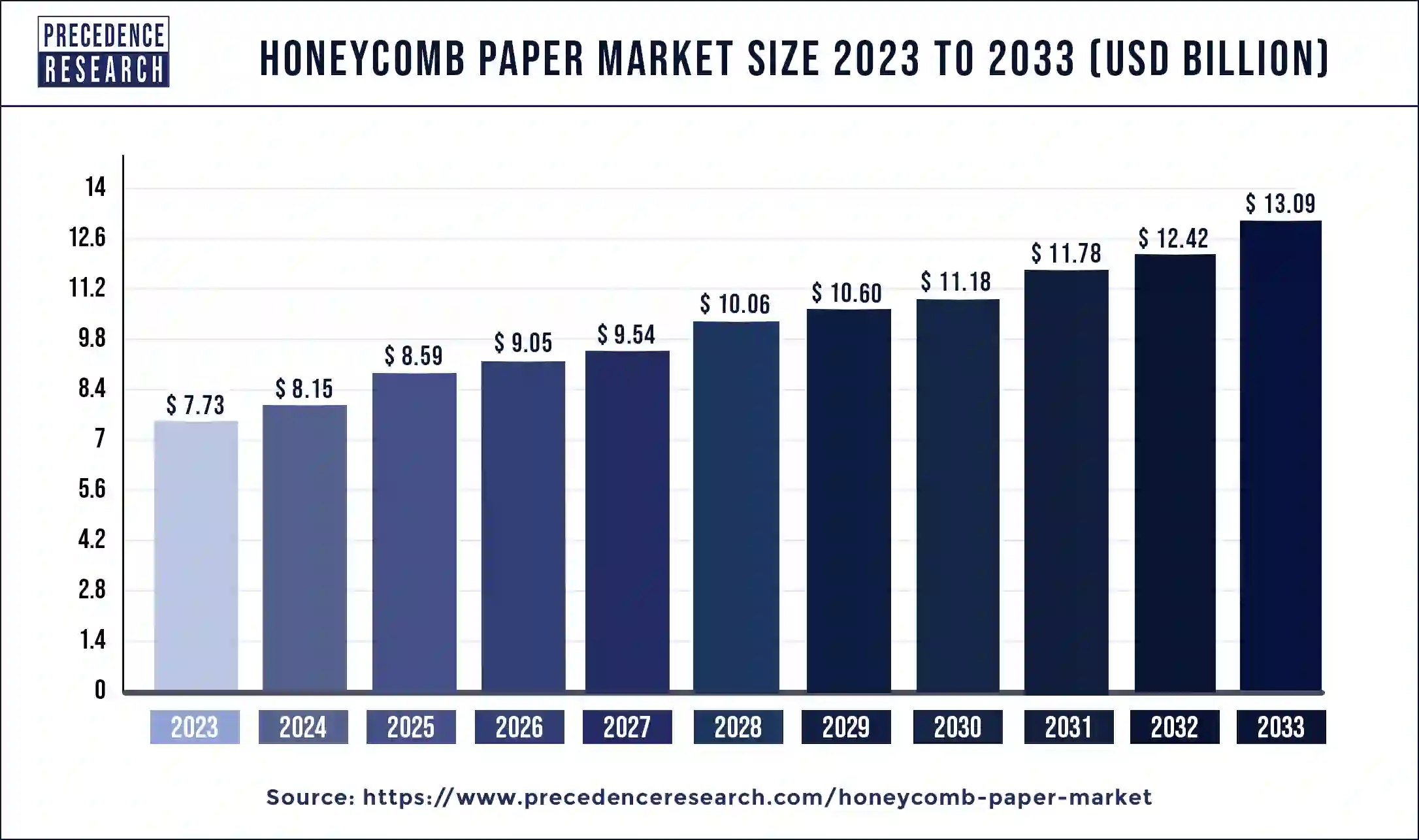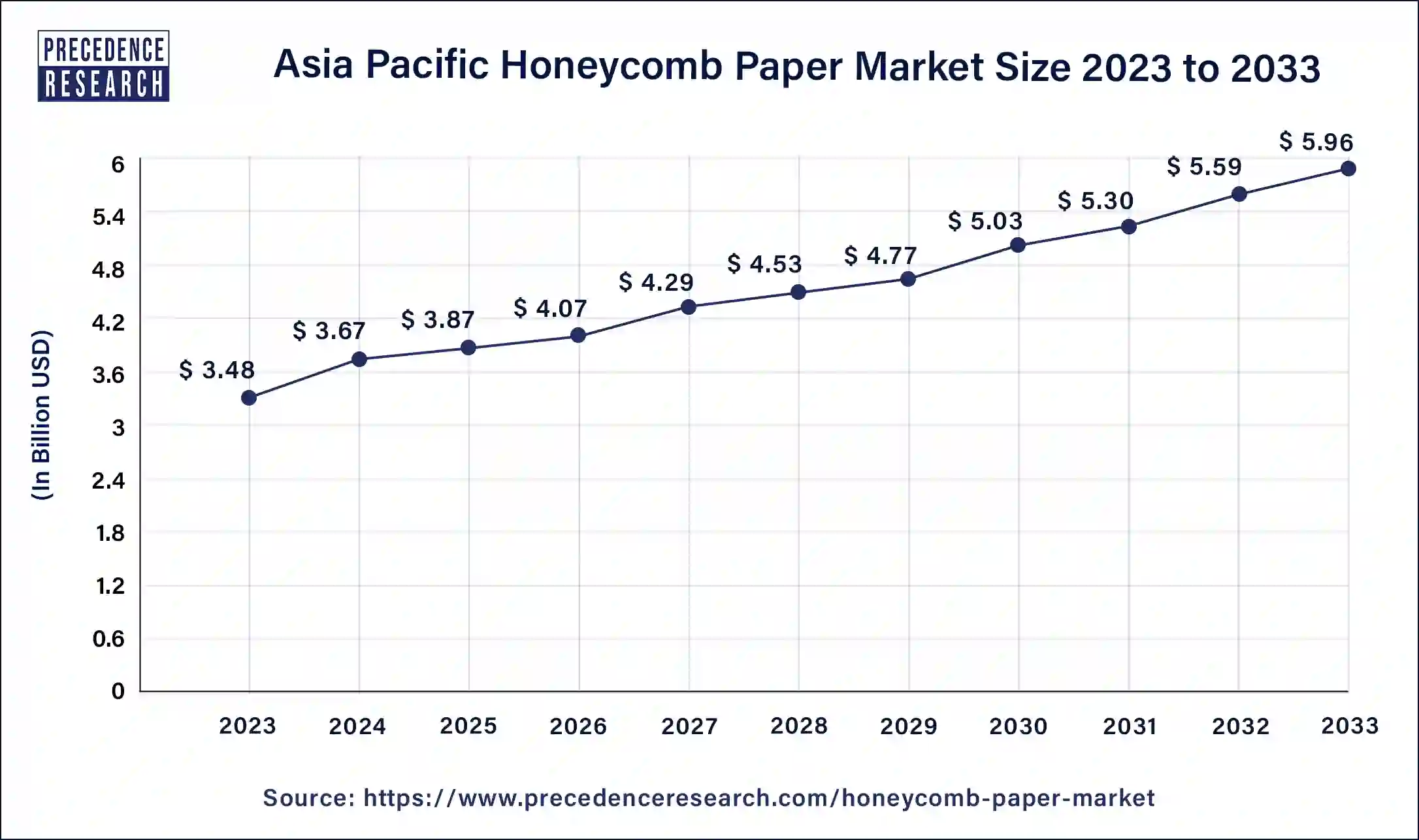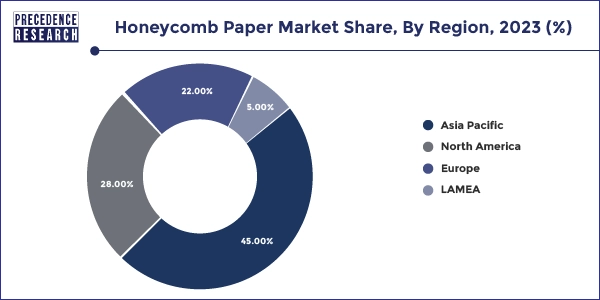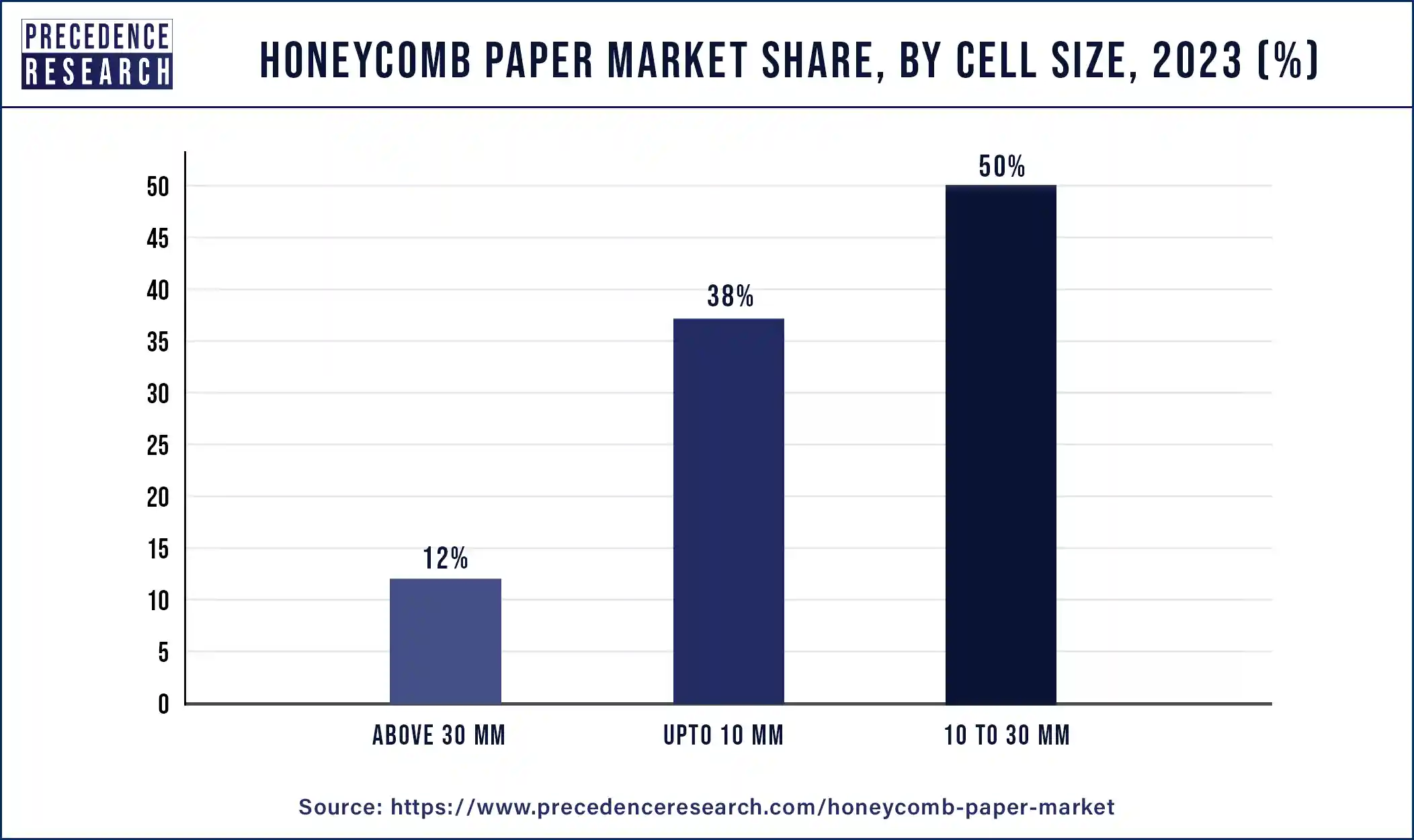January 2025
Honeycomb Paper Market (By Core Type: Expanded Paper Honeycomb, Expanded Paper Honeycomb Blocks Paper Honeycomb, Continuous Paper Honeycomb, Others; By Cell Size: Upto 10 mm, 10 to 30 mm, Above 30 mm; By End-use Industry: Home Decor, Transport and Logistics, Automotive, Building and Construction, Others) - Global Industry Analysis, Size, Share, Growth, Trends, Regional Outlook, and Forecast 2024-2033
The global honeycomb paper market size was valued at USD 7.73 billion in 2023 and is anticipated to reach around USD 13.09 billion by 2033, growing at a CAGR of 5.41% from 2024 to 2033. Manufacturers are looking for alternatives to reduce packaging cost, this factor is observed to expand the growth of the honeycomb paper market.

The Asia Pacific honeycomb paper market size was estimated at USD 3.48 billion in 2023 and is predicted to be worth around USD 5.96 billion by 2033, at a CAGR of 5.52% from 2024 to 2033.

Asia Pacific held the largest share of the honeycomb paper market in 2023. Further, the region is observed to sustain the position during the forecast period. The major reason behind this is, Asia Pacific region is undergoing rapid industrialization, driving demand for packaging, construction, automotive, and other sectors where honeycomb paper finds extensive applications. Increasing awareness among consumers regarding environmental sustainability is driving demand for eco-friendly packaging solutions, boosting the adoption of honeycomb paper in the region.
The booming e-commerce industry in Asia Pacific is fuelling the demand for innovative packaging solutions to ensure product protection during transit. Honeycomb paper's lightweight and strong properties make it an attractive choice for e-commerce packaging. Ongoing infrastructure development projects across countries like China, India, and Southeast Asian nations are driving demand for construction materials, including honeycomb paper for applications such as doors, partitions, and false ceilings. Supportive government policies and initiatives promoting sustainable practices and materials are further bolstering the growth of the honeycomb paper market in the Asia Pacific region.

North America is experiencing rapid growth in the honeycomb paper market due to increased demand for sustainable packaging solutions, driven by environmental concerns. Additionally, the growing e-commerce sector is fuelling demand for lightweight, protective packaging materials, where honeycomb paper excels. The United States and Canada are pivotal players in the rapidly growing honeycomb paper market in North America. In the United States, increased awareness about environmental sustainability is driving the demand for eco-friendly packaging solutions, with honeycomb paper being recognized for its recyclability and lightweight properties. The country's thriving e-commerce sector further amplifies this demand, as businesses seek efficient and protective packaging materials for shipping products.
Advancements in manufacturing technologies have also contributed to the market's expansion by enhancing the efficiency and versatility of honeycomb paper products. Moreover, the region's robust infrastructure and strong presence of key players in the packaging industry further stimulate growth. As a result, North America is emerging as a significant player in the global honeycomb paper market, poised for continued expansion in the coming years.
The North America honeycomb paper market size was calculated at USD 2.16 billion in 2023 and is projected to expand around USD 3.73 billion by 2033, poised to grow at a CAGR of 5.61% from 2024 to 2033.
| Year | Market Size (USD Billion) |
| 2023 | 2.16 |
| 2024 | 2.28 |
| 2025 | 2.41 |
| 2026 | 2.53 |
| 2027 | 2.67 |
| 2028 | 2.82 |
| 2029 | 2.97 |
| 2030 | 3.13 |
| 2031 | 3.30 |
| 2032 | 3.48 |
| 2033 | 3.73 |
Honeycomb Paper Market Overview
The honeycomb paper market continues to thrive, driven by its versatility and eco-friendly nature. With increasing emphasis on sustainability, industries ranging from packaging to construction are adopting honeycomb paper solutions. Its lightweight nature combined with impressive strength makes it ideal for reducing transportation costs and ensuring product protection.
Additionally, honeycomb paper's recyclability aligns with consumer demands for environmentally conscious options. Industries such as automotive, furniture, and consumer goods are increasingly integrating honeycomb paper into their manufacturing processes to enhance product performance while minimizing environmental impact.
Moreover, advancements in manufacturing technology are further fueling market growth, enabling customization and scalability to meet diverse industry needs. The market's upward trajectory is projected to persist as more industries recognize the economic and environmental benefits of honeycomb paper solutions, positioning it as a key player in the global packaging and materials market.
| Report Coverage | Details |
| Growth Rate from 2024 to 2033 | CAGR of 5.41% |
| Honeycomb Paper Market Size in 2023 | USD 7.73 Billion |
| Honeycomb Paper Market Size in 2024 | USD 8.15 Billion |
| Honeycomb Paper Market Size by 2033 | USD 13.09 Billion |
| Largest Market | Asia Pacific |
| Base Year | 2023 |
| Forecast Period | 2024 to 2033 |
| Segments Covered | By Core Type, By Cell Size, By End-use Industry |
| Regions Covered | North America, Europe, Asia-Pacific, Latin America, and Middle East & Africa |
Driver
Eco-friendly option for packaging
One significant driver propelling the honeycomb paper market forward is its exceptional eco-friendliness. As global awareness of environmental issues continues to rise, industries are under increasing pressure to adopt sustainable practices and materials. Honeycomb paper emerges as a compelling solution due to its inherently eco-friendly characteristics. honeycomb paper is highly recyclable. After serving its primary purpose, it can be easily recycled into new products or materials, minimizing waste and conserving natural resources. This recyclability aligns with circular economy principles, where resources are kept in use for as long as possible through recycling and repurposing.
Moreover, the production process of honeycomb paper typically involves fewer environmental impacts compared to traditional materials like plastics or metals. It often requires less energy and generates fewer greenhouse gas emissions, contributing to a lower carbon footprint overall.
Overall, the eco-friendliness of honeycomb paper makes it an attractive choice for industries striving to meet sustainability goals and consumer preferences for environmentally responsible products. As environmental concerns continue to drive market trends, the demand for honeycomb paper is expected to grow steadily in the coming years.
Restraint
Significant initial investment
Despite its numerous benefits, one significant restraint facing the honeycomb paper market is the significant initial investment to adopt it along with competition from alternative materials, particularly those derived from petrochemicals. While honeycomb paper offers eco-friendly advantages, such as recyclability and renewable sourcing, it faces tough competition from materials like plastics and metals, which have established market and may offer certain performance advantages in specific applications.
Moreover, the initial investment and transition costs associated with adopting honeycomb paper solutions can deter some industries from making the switch. For companies accustomed to using traditional materials, such as plastics or metals, integrating honeycomb paper into their manufacturing processes may require substantial investments in equipment with training which can pose a barrier to entry.
Opportunity
Adoption from the aerospace industry
An exciting opportunity for the honeycomb paper market lies within the aerospace industry, particularly in aircraft interiors and components. Honeycomb paper's lightweight yet robust characteristics make it well-suited for various applications within aircraft design and manufacturing. One notable opportunity is in the production of aircraft interior panels. Honeycomb paper panels can be used to create lightweight, durable, and customizable interior components such as overhead bins, cabin partitions, and bulkheads. These components can contribute to reducing the overall weight of the aircraft, leading to fuel savings and improved operational efficiency which is a critical consideration for airlines aiming to lower their operating costs and reduce carbon emissions.
The continuous paper honeycomb segment led the honeycomb paper market in 2023 and the segment is observed to continue the growth at a considerable rate during the forecast period. Continuous paper honeycomb cores offer exceptional strength-to-weight ratios, making them ideal for lightweight construction applications such as aerospace, automotive, and marine industries. As industries increasingly prioritize fuel efficiency and sustainability, the demand for lightweight materials like continuous paper honeycomb cores is expected to rise.
Continuous paper honeycomb cores are typically made from recycled paper or sustainably sourced paper pulp, aligning with the growing emphasis on environmental sustainability. As regulations tighten and consumer preferences shift towards eco-friendly products, manufacturers are likely to prefer materials with lower environmental footprints, thus driving the demand for continuous paper honeycomb cores.
Continuous paper honeycomb cores can be easily customized to meet specific design and performance requirements, offering versatility across a wide range of applications. Whether it's providing thermal insulation, acoustic damping, or structural reinforcement, continuous paper honeycomb cores can be tailored to suit various industry needs, thereby expanding their market potential.
The 10-30 mm cell size segment held a significant share of the market in 2023. Similarly, the segment is observed to witness a significant growth rate in the honeycomb paper market in during the forecast period. Honeycomb structures with cell sizes between 10-30 mm offer a balance between strength and weight, making them suitable for a wide range of applications requiring structural integrity and stability. The 10-30 mm cell size range caters to various industries, including aerospace, automotive, construction, packaging, and furniture. Its versatility makes it adaptable to different manufacturing processes and product requirements, driving demand across multiple sectors.

Despite their robustness, honeycomb structures with 10-30 mm cell sizes remain lightweight, contributing to fuel efficiency in transportation applications and reducing overall product weight without compromising strength. Honeycomb structures with smaller cell sizes within the 10-30 mm range offer improved energy absorption capabilities, making them suitable for applications requiring impact resistance and crashworthiness, such as automotive crash structures and protective packaging. As environmental concerns continue to drive market trends, the use of honeycomb structures with 10-30 mm cell sizes aligns with sustainability goals due to their recyclability and potential use of eco-friendly materials. Continuous improvements in manufacturing processes and material compositions enable the production of honeycomb structures with precise cell sizes within the 10-30 mm range, enhancing their performance and affordability.
In the honeycomb paper market, the home decor segment stands out as a dominant end-use segment and is poised for further growth. With increasing awareness of environmental sustainability, consumers are gravitating towards eco-friendly home decor options. Honeycomb paper products fit this trend perfectly, as they are made from recyclable materials and are biodegradable, appealing to environmentally conscious consumers. Honeycomb paper offers immense versatility in design, allowing for the creation of unique and visually appealing home decor items such as lampshades, room dividers, wall art, and decorative accents. The ability to customize shapes, colours, and patterns makes honeycomb paper an attractive choice for interior designers and homeowners seeking distinctive decor elements.
Honeycomb paper products are lightweight and easy to handle, making them convenient for DIY home decor projects. Unlike traditional materials like wood or metal, honeycomb paper requires minimal installation effort and can be easily mounted or assembled, appealing to consumers looking for hassle-free decorating solutions. Honeycomb paper products often offer cost advantages compared to traditional home decor materials, making them accessible to a wider range of consumers. This affordability factor contributes to the growing popularity of honeycomb paper in the home decor market.
Manufacturers are continually innovating and expanding their product offerings in the honeycomb paper home decor segment. From new shapes and designs to improved durability and functionality, ongoing advancements drive consumer interest and market growth.
Segments Covered in the Report
By Core Type
By Cell Size
By End-use Industry
By Geography
For inquiries regarding discounts, bulk purchases, or customization requests, please contact us at sales@precedenceresearch.com
No cookie-cutter, only authentic analysis – take the 1st step to become a Precedence Research client
January 2025
February 2025
November 2023
July 2024